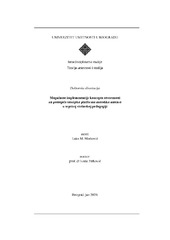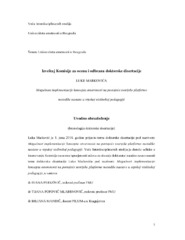| dc.contributor.advisor | Perković, Ivana | |
| dc.contributor.other | Popović Mlađenović, Tijana | |
| dc.contributor.other | Daković, Nevena | |
| dc.contributor.other | O Brajen, Nada | |
| dc.contributor.other | Marković, Vladimir | |
| dc.creator | Marković, Luka | |
| dc.date.accessioned | 2020-09-15T10:54:20Z | |
| dc.date.available | 2020-09-15T10:54:20Z | |
| dc.date.issued | 2020-12-11 | |
| dc.date.submitted | 2020-09-14 | |
| dc.identifier.uri | http://eteze.arts.bg.ac.rs/handle/123456789/464 | |
| dc.description.abstract | U međusobnoj razmeni savremenih kulturoloških disciplina, muzičke prakse i njenih teorijskih
platformi, doskora je najmanje učestvovala muzička pedagogija. Problematizujući ovaj nedostatak
u srpskoj violinskoj pedagogiji, u radu je primenjena ideja otvorenog pristupa u
istraživanju propustljivosti granica teorijskog sistema violinizma, kao posebne naučno-umetničke
discipline.
Koncept otvorenosti, kao metodski postupak u razradi teme, shvaćen je kao opšti princip
promenljivosti, rekonstruktivnosti i fleksibilnosti. Primenljivost ovog metodskog modela zasnivala
se na hipotezi da konceptualizacija osnovnih postulata violinske pedagogije može da
omogući naturalizaciju i hibridizaciju znanja iz drugih umetnosti i nauka, kroz diskurs interdisciplinarnosti.
Pretpostavka je bila i da uvođenje novih paradigmatskih diskursa u dosadašnje obrasce
školovanja (koji su uslovljeni i specifičnim dispozitivima komponovanja i postmodernističkim
poetikama izvođenja) ne bi poništilo ni jedan verifikovani protokol institucionalizovanog
didaktičkog okvira.
U srpskoj teorijskoj praksi sistem nastave violine razmatran je kroz pet naučno-umetničkih
segmenata: istorijsko iskustvo, opštu pedagogiju i didaktiku, psihološke odrednice, psihomotorne
senzacije i sredstva muzičko-umetničkog izražavanja. U kritičkom pristupu ovim
temama, formirala se i osnovna teza rada: da poznavanje konvencionalnih postulata nastave
violine predstavlja utoliko održiviji sistem, ukoliko liminalnost njegovih granica (kao rubni
prostor) omogućava veću prohodnost vandisciplinarnih znanja i tehnika.
Rekonstrukcijom cikličnog istorijskog toka violinske pedagogije u genealoški poredak;
hibridizacijom progresivnog obrazovanja novim tehnikama psihopedagogije; uvidom u morfologiju
senzomotornih aktivnosti i kontekstualizacijom muzičkog mišljenja, modeli nastave
pokazali su potencijal predstavljanja kao sistema u pokretu.
To je bio i cilj rada: ukazivanje na mogućnost unošenja invencija u konvencije teorija
violinizma, čime bi metodika nastave violine mogla da postane izmenljivo, živo teorijsko (i
u praksi primenljivo) polje u kome će se uvek naći opravdanje za različite načine i poetike
učenja, tumačenja i izvođenja muzičkog dela (preobražavanje teksta u kontekst), ne gubeći
iz vida autonomnost same discipline. | en |
| dc.description.abstract | Music pedagogy has until recently participated the leastin international exchange of contemporary
and cultural disciplines, music practice and its theoretical platforms. By problematizing
this shortcoming in Serbian violin pedagogy, this work has applied an idea an the open-approach
in researching the permeability of theoretical system of violin studies, as a particular
scientific and artistic discipline.
The concept of openness is, as a methodological procedure in theme development, understood
as a general principle of variability, reconstruction and flexibility. Application of this
methodological model is based upon a hypothesis that the conceptualization of fundamental
principles of violin pedagogy can provide knowledge naturalization and hybridization in
other arts and sciences through the discourse of interdisciplinarity.
An assumption was that the intervening of new paradigmatic discourses in present schooling
patterns (which are conditioned by specific composing dispositions and postmodern performing
poetics as well) would not discard any of verified procedures of institutional didactical
setting.
Violin teaching method in Serbian theoretical practice has been analyzed by five scientific
and artistic approaches: historical experience, general pedagogy and didactics, psychological
traits, psychomotor activities and musical and artistic skills. Critical approach to theaforementionedsubjects
has created the primary thesis of this work: competence in
conventional postulates of violin teaching presents a sustainable system, the more liminal its
boundaries are. If understood as borderlines they can provide greater influence of extradisciplinary
knowledge and technics.
Reconstruction of cyclic historical flow of violin pedagogy into a genealogical order;
hybridization of progressive education by new technics of psychopedagogy; insight into morphology
of sensomotoric activities and contextualization of musical opinion have shown that
teaching models can be presented as a system in motion.
Precisely that was an objective of this work: emphasizing the possibility of inventions in
conventional violin theories, by which the violin teaching methods could become an interchangeable,
lively theoretical (in practice applicable) field of different study-modes and poetics,
interpretations and performances of musical piece (transcription of text into context),
without dismissing the autonomy of the discipline itself. | en |
| dc.language.iso | sc | en |
| dc.publisher | Универзитет уметности у Београду, Интердисциплинарне студије Универзитета уметности | sr |
| dc.source | Интердисциплинарне студије Универзитета уметности | sr |
| dc.subject | koncept otvorenosti, kontekstualizacija violinske metodike, genealogija pedagoškog iskustva, psihomotorne relacije, psihopedagoške tehnike, hibridizacija, naturalizacija, interdisciplinarnost | en |
| dc.subject | open-approach concept, contextualization of violin methodology, genealogy of pedagogical experiences, psychomotor relations, psycho-pedagogical technics, hybridization, naturalization, interdisciplinarity | en |
| dc.title | Mogućnost implementacije koncepta otvorenosti na postojeće teorijske platforme metodike nastave u srpskoj violinskoj pedagogiji | en |
| dc.type | doctoralThesis | en |
| dcterms.abstract | Перковић, Ивана; Поповић Млађеновић, Тијана; О Брајен, Нада; Марковић, Владимир; Даковић, Невена; Марковић, Лука; | |


